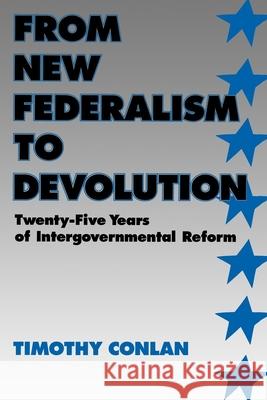From New Federalism to Devolution: Twenty-Five Years of Intergovernmental Reform » książka
From New Federalism to Devolution: Twenty-Five Years of Intergovernmental Reform
ISBN-13: 9780815715313 / Angielski / Miękka / 1998 / 392 str.
From New Federalism to Devolution: Twenty-Five Years of Intergovernmental Reform
ISBN-13: 9780815715313 / Angielski / Miękka / 1998 / 392 str.
(netto: 92,10 VAT: 5%)
Najniższa cena z 30 dni: 96,90
ok. 30 dni roboczych
Bez gwarancji dostawy przed świętami
Darmowa dostawa!
In the period from 1970 to the early 1990s, Republican leaders launched three major reforms of the federal system. Although all three initiatives advanced decentralization as a goal, they were remarkably different in their policy objectives, philosophical assumptions, patterns of politics, and policy outcomes. Expanding and updating his well-received book, New Federalism: Intergovernmental Reform from Nixon to Reagan, (1988), Timothy Conlan provides a comprehensive look at intergovernmental reform from Nixon to the 104th Congress. The stated objectives of Republican reformers evolved from rationalizing and decentralizing an activist government to rolling back the welfare state to replacing it altogether. Conlan first explains why conservatives have placed so much emphasis on federal reform in their domestic agendas. He then examines Nixon's New Federalism, including management reforms and revenue sharing; analyzes the policies and politics of the Reagan revolution; and reviews the legislative limitations and achievements of the 104th Congress. ideology during the past 30 years and provides alternative scenarios for the future of American federalism. Timothy Conlan is an Associate Professor of Government and Politics at George Mason University. He was formerly on the staff of the Senate Subcommittee on Intergovernmental Relations and the US Advisory Commission on Intergovernmental Relations. Conlan is the author of numerous books, articles, and monographs on federalism, American politics, and public policymaking, including Taxing Choices: The Politics of Tax Reform (Congressional Quarterly, 1989).











